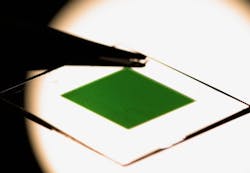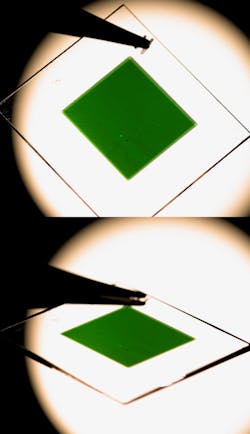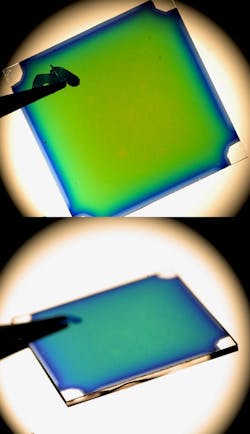Thin-film polariton filters for better displays, sensors, and optical imaging?
A team of researchers led by Malte Gather, director of the Humboldt Centre for Nano- and Biophotonics at the University of Cologne in Germany as well as a professor at the University of St. Andrews in Scotland, and Andreas Mischok, a postdoctoral researcher at the University of Cologne, recently figured out a way to design thin-film polariton filters that break the fundamental limit of angular dispersion (see video).
While optical filters are necessary for many applications, they come with baggage: Their performance tends to decrease significantly when light strikes them at different angles—and this can negatively impact the accuracy of optical sensors.
Gather’s group has worked on lasers made of organic materials for many years, including extensive research into polariton lasers (polaritons are half light/matter quasiparticles), and they made a serendipitous discovery about polariton dispersion.
“The dispersion relation of polariton lasers is routinely measured by our community, and we noticed that under specific conditions the dispersion of polaritons becomes very flat—their energy changes only weakly with angle—much less so than the energy of photons within a conventional laser, for example,” says Gather.
Quantum mechanics
Thin-film filters today consist mainly of alternating layers of metal oxides, and light is partially reflected or transmitted through the individual layers. The layer thickness determines the color of the transmitted light via constructive and destructive interference of the light waves (akin to the iridescent colors of soap bubbles). This makes the filters susceptible to angular dispersion (blueshift) when tilted.
By integrating strongly absorbing organic dyes into stacks of thin films, the team creates strong coupling of interfering light with the dyes. This leads to the formation of new quasiparticles: Exciton polaritons. Exciton polaritons share characteristics of both of their constituents—they are quite literally part light, part matter.
Using this quantum mechanical effect of strong light-matter coupling enabled the researchers to design thin-film optics that break the fundamental limit of angular dispersion of thin-film optics. While the angular dispersion in conventional thin-film optics depends almost exclusively on film thickness and refractive index, the dispersion of polaritons can be further tailored by adjusting parameters such as the strength of the coupling. This allowed the researchers to flatten the angular dispersion compared to what was previously considered possible.
“In other words: Compared to conventional thin-film optics, our polariton filters show almost no shift in color and spectrum upon tilting. Changes in spectrum with angle were a key issue in high-performance optics up until now, and we expect that overcoming this fundamental limit will unlock new and significantly more efficient optical designs,” says Gather.
How do their filters work? “Our filters work by coupling light within multilayer coatings with strongly absorbing organic materials,” explains Mischok. “These materials are strategically placed as thin films inside the optical layer stack to ensure maximum light-matter interaction. As a result, we’re converting the purely optical filter into a polariton filter that combines the behavior of both photons and material resonances.”
In conventional optical coatings, “it’s important to avoid any absorption of light by the filter material to ensure maximum transmission,” says Mischok. “Instead, we introduce strong absorption at key wavelengths. Somewhat surprisingly, this doesn’t diminish the optical quality of the final filter—polariton filters can reach competitive transmission values of up to 98%, a value that other angle-independent filter technologies have failed to reach so far. This performance was really unexpected, and it’s probably part of the reason why this approach wasn’t explored before.”
Working with Professor Koen Vandewal from Hasselt University in Belgium, the team integrated their polariton filters into organic photodiodes and created narrowband photodetectors. This will likely enable hyperspectral imaging advances for material characterization and compact optical sensors.
The team says their approach also shows potential for polymers, perovskites, quantum dots, and other materials because it takes the new filter principle to an even wider wavelength range.
Design freedom/timeline
Fully angle-independent filters “give optical engineers much more freedom when designing new devices—from fluorescent microscopes to virtual reality glasses to optical sensors,” says Mischok. “Before, filters could only be placed at a position where the divergence of light is controlled. By lifting this restriction, optical components can be miniaturized, made more reliable and cheaper, or completely redesigned for efficiency.”
The team is particularly interested in applications of their technology within lab-on-chip devices and for large field-of-view computer vision, including light detection and ranging (LiDAR), but they see broad potential in many more directions. “We believe polariton filters can be used in such devices within the next couple of years,” says Mischok.
What’s next for the team? “We’re actively working to bring our polariton filter technology to market,” says Gather. “Very recently, our team secured substantial funding from the German government through the EXIST program to prepare commercialization of polariton filters for computer vision.”
Gather also believes polariton devices offer exciting opportunities for the display industry, in which very large field-of-view and saturated color are key characteristics to differentiate the next generation of products. “But a number of fundamental questions remain about how polariton filters operate and whether there are ultimately any limits on how flat their angle response can be,” he adds. “We look forward to exploring these as part of an advanced grant I was awarded by the European Research Council.”
FURTHER READING
A. Mischok et al., Nat. Commun., 15, 10529 (2024); https://doi.org/10.1038/s41467-024-54623-1.
About the Author
Sally Cole Johnson
Editor in Chief
Sally Cole Johnson, Laser Focus World’s editor in chief, is a science and technology journalist who specializes in physics and semiconductors.



